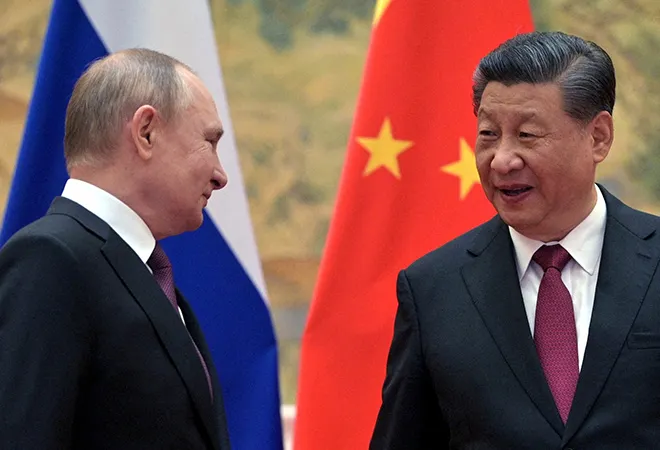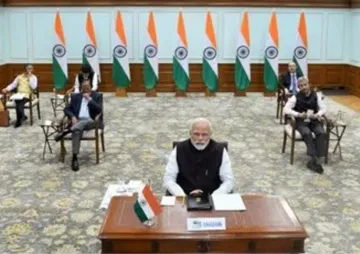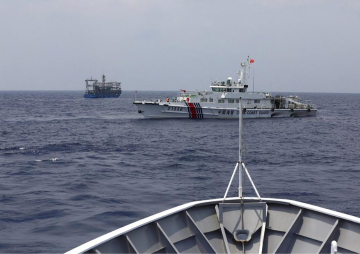
China’s consistent economic growth, driven by wide-ranging capital investments and a thriving manufacturing sector, has made it the world’s largest energy consumer. Consequently, Beijing has found a reliable trade partner for energy commodities such as oil, gas, and coal in fossil fuel-rich neighbouring Russia. This relationship’s mutual affinity and security issues have been discussed and examined in recent years. The Ukrainian war and the subsequent Western sanctions on Russia have further driven Russian interests eastwards towards China and India. This article analyses Russia’s energy sector and illustrates an array of Chinese acquisitions in Russian oil and gas companies financed by China’s state-owned banks and companies.
< style="color: #163449">A reliable partnership between the Russian state energy complex and China
China became a net oil importer post-1992. China consumed 14.13 million barrels daily in 2021, 14 percent more than the International Energy Agency’s 2015 forecast of 9.5 million. The periods of intense economic growth in 2002-03 and 2007-09 further accelerated its oil demand. To overcome China’s exacerbated strategic and economic vulnerabilities caused by ever-growing imports, Beijing devised a “loans-for-oil” policy and equity investments (with a buyback option in exchange for oil imports) to create resilient and diversified energy supply chains.
The era of strategic cooperation between state-owned Russian energy companies and Chinese national oil companies, especially between Rosneft and China National Petroleum Corporation (CNPC), began in 2004 following the “Yukos affair”. Yukos, one of Russia’s biggest private oil and gas suppliers, was driven to bankruptcy following tax fraud allegations, allowing China to up its ante. CNPC facilitated Rosneft’s acquisition of Yukos’ subsidiary, Yuganskneftegaz, a major oil producer, by allowing Rosneft to buy back controlling shares from CNPC. In return, China earned a sustained oil supply of 49 million tonnes annually.
Table 1: Chinese Stakes in Russia’s State Oil and Gas Companies
| S. No. |
Year |
Investor |
Transactional party |
Quantity in Millions ($) |
Share size in percentages |
| 1. |
2006 |
China National Petroleum Corp. (CNPC) |
Rosneft |
500 |
0.62 |
| 2. |
2009 |
China Investment Corporation (CIC) |
Nobel Holdings |
300 |
45 |
| 3. |
2010 |
China Huadian Corporation (CHC) |
JSC Territorial |
360 |
51 |
| 4. |
2011 |
Three Gorges |
EuroSibEnergo |
2290 |
50 |
| 5. |
|
CHC |
TGC-S |
590 |
100 |
| 6. |
2013 |
State Grid |
Sintez |
1140 |
N/A |
| 7. |
2013 |
Shenhua |
En+ |
460 |
50 |
| 8. |
2014 |
CNPC |
Rosneft |
990 |
10 |
| 9. |
2014 |
Power Construction Corporation (Power China) |
RusHydro |
1460 |
49 |
| 10. |
2014 |
CNPC |
Novatek |
940 |
20 |
| 11. |
2015 |
State Administration of Foreign Exchange (SAFE) |
Novatek |
1210 |
10 |
| 12. |
2015 |
China Petroleum and Chemical (Sinopec) |
Sibur |
1340 |
10 |
| 13. |
2016 |
SAFE |
Sibur |
1150 |
10 |
| 14. |
2016 |
CEFC China Energy |
EN+ |
500 |
N/A |
| 15. |
2017 |
CIC |
Eurasia Drilling |
100 |
6 |
| 16. |
2019 |
CNPC |
Rosneft |
9100 |
18 |
Source: Oxford Energy, Russian Government data, Chinese Government data, Reuters
A rough calculation of its investments in Russia between 2005 to 2021 reveals that Chinese state companies have invested a staggering US$ 95 billion in energy infrastructure while also investing US$ 48 billion in acquiring stakes in Russian state oil and gas companies.
Table 2: China-funded Energy Infrastructure Projects in Russia
| S. No. |
Subsector |
Project |
Contractor |
Chinese investments in US$ |
Year |
| 1 |
Gas |
Amur gas processing plant (GPP)* |
China Petroleum Engineering & Construction (CPECC)* |
12,700 |
2015 |
| 2 |
Gas |
Power of Siberia Gas Pipeline |
China National Petroleum Corporation (CNPC) |
N/A |
2019 |
| 3 |
Gas |
Ust-Luga Gas and Chemical Complex* |
China National Chemical Engineering (CNCE)* |
13,300 |
2019 |
| 4 |
Gas |
Amur Gas Chemical Complex (40% stake) |
CNPC |
11,600 |
2019 |
| 5 |
Gas |
Yamal LNG Export Facility (20% + 10% stake) |
China National Offshore Oil Corporation (CNOOC), Silk Road Fund (SRF) |
5,900 |
2017 |
| 6 |
Gas |
Arctic-2 Liquefied Natural Gas Project (20% stake) |
CNPC, CNOOC |
4,040 |
2020 |
| 7 |
Gas |
Chayandinskoye LNG plant (10% stake) |
CNCE |
1,170 |
2019 |
| 8 |
Gas |
Process modules (Arctic LNG-2)* |
Bomsec OffShore Engineering* |
520 |
2019 |
| 9 |
Oil |
Eastern Siberia Pacific Ocean Pipeline* |
CNPC* |
25,000 |
2009 |
Source: Oxford Energy, Russian Government data, Chinese Government data, Reuters; *fully funded by China
Chinese financial interventions strategically reallocated and built assets crucial to Russia's energy economy, helping Russia consolidate its “Pivot to Asia” policy. Political will at the highest rungs of both governments, Beijing’s vast financial resources, Russia’s “Look East” policy, Western sanctions of 2014 and subsequent alienation reinforced this partnership.
< style="color: #163449">Oil-for-Loans
The Eastern Siberia Pacific Ocean Pipeline (ESPO) project, crucial to oil transit between the two nations, highlights China’s “oil-for-loans” policy. ESPO provided Beijing with a land-based route for China’s energy trade and was thus most critical in ensuring China’s energy supply stability. Russian President Vladimir Putin termed the trade deal worth US$ 25 billion as the “Gateway to the East”.
CNPC funded ESPO in exchange for delivering 15 million tonnes of oil annually to China till 2030. Rosneft and Transneft agreed to a daily supply 0.18 million barrels and 0.12 million barrels. China Development Bank (CDB) facilitated the loan to the Russian energy giants at CNPC’s behest. CDB held the authority to deduct money directly from these accounts to ensure timely repayments. If a default occurred, CDB could withdraw the entire funds from the accounts.
< style="color: #0069a6">ESPO provided Beijing with a land-based route for China’s energy trade and was thus most critical in ensuring China’s energy supply stability.
CNPC accounts for the bulk of imports from the ESPO; China National Chemical Corporation (ChemChina), Sinochem Group and China National Offshore Oil Corporation (CNOOC) are the other major buyers. Russia’s Rosneft still accounts for 40 percent of the total ESPO exports. Yet, players like SurgutNG account for roughly 27 percent of the ESPO crude going to China and other recipients, including Japan and South Korea.
This energy axis also helped the partners de-dollarise bilateral trade, as China agreed to pay in Rubles and Yuan from September 2022.
< style="color: #163449">Weathering Western sanctions of 2014
The Sino-Russian bilateral relations go beyond commerce and trade. As Western sanctions, imposed after Russia’s annexation of Crimea in 2014, began taking a toll on the Russian economy, President Putin and President Xi struck a deal that would cushion the sanctions’ blows, leading to separate deals between CNPC and Rosneft, Novatek and China Petroleum and Chemical Corporation (Sinopec) and Rosneft, Sibur.
However, this was different in the financial sector. As major Chinese banks complied with the Western sanctions, Russia missed out on potential foreign investments worth US$ 471 billion. To circumvent the sanctions, some Chinese banks facilitated aid to Russia through CDB, Silk Road Fund (SRF), and Chinese state companies – all less connected to the global economy, thereby suited to undertake riskier investments. A case in point is SRF’s financial assistance to Novatek in December 2015 and the subsequent purchase of 10 percent stakes in the Yamal LNG project. In April 2016, CDB extended a US$ 10-billion loan for the same project. Sinopec reportedly paid US$ 15 billion in prepayment for gas imports to stabilise Rosneft’s financial position. Sinopec and ChemChina also bought controlling stakes in Rosneft following its privatisation in 2014.
< style="color: #0069a6">To circumvent the sanctions, some Chinese banks facilitated aid to Russia through CDB, Silk Road Fund (SRF), and Chinese state companies – all less connected to the global economy, thereby suited to undertake riskier investments.
< style="color: #163449">Conclusion
Between 2014 and 2019, Putin and Xi met 30 times, emphasising the resilience and growth of the Sino-Russian energy relations. In November 2022, at the fourth China-Russia Energy Business Forum, Xi labelled the energy partnership as the bilateral’s cornerstone. The growing convergence, convenience, and alignment of energy interests have made the Sino-Russian bilateral relations the most amicable in their history. China is financing energy infrastructure across the global energy economy to create resilient supply chains for itself. But, with energy transition and grid decarbonisation gaining prominence, how long will such fossil-fuel friendships remain relevant is the million-dollar question.
The views expressed above belong to the author(s). ORF research and analyses now available on Telegram! Click here to access our curated content — blogs, longforms and interviews.




 PREV
PREV


